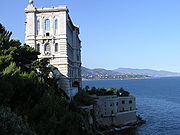
Oceanographic Museum
Encyclopedia

Monaco-Ville
Monaco-Ville is one of Monaco's administrative divisions located on a rocky headland that extends into the Mediterranean Sea. It is one of the four traditional quarters of Monaco, the others being La Condamine, Monte Carlo, and Fontvieille. However, in modern administrative terms it is one of ten...
, Monaco
Monaco
Monaco , officially the Principality of Monaco , is a sovereign city state on the French Riviera. It is bordered on three sides by its neighbour, France, and its centre is about from Italy. Its area is with a population of 35,986 as of 2011 and is the most densely populated country in the...
.
History
The Oceanographic Museum was inaugurated in 1910 by Monaco's modernist reformer, Prince Albert IAlbert I, Prince of Monaco
Albert I was Prince of Monaco and Duke of Valentinois from 10 September 1889 until his death.-Early life:...
. This monumental architectural work of art has an impressive façade above the sea, towering over the sheer cliff face to a height of 279 feet (85.04 m). It took 11 years to build, using 100,000 tons of stone from La Turbie
La Turbie
La Turbie is a commune in the Alpes-Maritimes department in southeastern France.-History:...
.
Overview
The museum is home to exhibitions and collections of various species of sea fauna (starfish, seahorses, turtles, jellyfish, crabs, lobsters, rays, sharks, sea urchins, sea cucumbers, eels, cuttlefish etc.) both stuffed and in skeletal form. The museum's holdings also include a great variety of sea related objects, including model ships, sea animal skeletons, tools, weapons, etc.An aquarium located in the basement of the museum showcases a wide array of flora and fauna. Four thousand species of fish and over 200 families of invertebrates can be seen. The aquarium also features a presentation of Mediterranean and tropical marine ecosystems.
Jacques-Yves Cousteau
Jacques-Yves Cousteau
Jacques-Yves Cousteau was a French naval officer, explorer, ecologist, filmmaker, innovator, scientist, photographer, author and researcher who studied the sea and all forms of life in water...
was its director for many years, beginning in 1957. The Museum celebrated its 100th birthday in March 2010, after extensive renovations.
Controversy
In 1989, French marine biologist Alexandre Meinesz discovered a patch of a giant, tropical seaweed Caulerpa taxifoliaCaulerpa taxifolia
Caulerpa taxifolia is a species of seaweed, an alga of the genus Caulerpa. Native to the Indian Ocean, it has been widely used ornamentally in aquariums. The alga has a stem which spreads horizontally just above the seafloor, and from this stem grow vertical fern-like pinnae, whose blades are flat...
directly under the walls of the museum. Several documentaries point to this patch as the origin of one of the largest seaweed contaminations of the Mediterranean Sea in recent history. The role of the museum and its director (Francois Doumenge) when the discovery was made public is still heavily debated.

